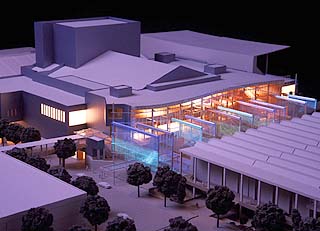|
Subscribe / Renew |
|
|
Contact Us |
|
| ► Subscribe to our Free Weekly Newsletter | |
| home | Welcome, sign in or click here to subscribe. | login |
Architecture & Engineering
| |
 |
June 5, 2003
At McCaw Hall, the performance begins outside
LMN Architects

Photo by Mike Zens
McCaw Hall’s five-story glass curtain wall and colorful metal scrims are designed to light up Mercer Street and offer an inviting backdrop for the action inside.
|
Marion Oliver McCaw Hall will become the centerpiece of the Seattle Center performing arts district, and home to two of the nation’s premier performing arts companies, the Pacific Northwest Ballet and the Seattle Opera.
The performance hall will also provide a new venue for touring artists, civic events and community lectures, and cultural festivals such as the International Children’s Festival, Northwest Folklife and Bumbershoot.
McCaw Hall, formerly the Seattle Opera House, defines the urban edge of the Seattle Center — a 74-acre civic, cultural and entertainment campus, much of which was built for the 1962 World’s Fair.
The $127 million, 295,000-square-foot redevelopment includes a new arrival court and public lobbies; complete restructuring of the interior plan; replacement of the five-story building envelope; extensive life-safety and seismic improvements; new mechanical, electrical and theatrical systems; a renovated rehearsal hall; new backstage spaces; and a redesigned 2,900-seat performance hall.
Although portions of the auditorium shell core embrace both the original auditorium structure of 1928 as well as the 1962 renovation, the hall was significantly reconfigured to improve sightlines, acoustics and intimacy. A 400-seat lecture hall, cafe and lounge spaces for performers and patrons have also been added.
An immersion experience
The experience of attending a performance is enhanced by the architecture of the venue, which provides the form for the experience. Arrival at McCaw Hall transforms the act of attending a performance into an immersion experience by drawing the ephemeral qualities and sensations of the performances beyond the stage and out into the streetscape.
The grand lobby faces a pedestrian corridor that connects Mercer Street, an urban traffic arterial, to the Seattle Center campus. The historical building footprint left no allowance for a traditional public sequence leading to the performance hall, making it necessary to use an alternative design strategy.
The design approach creates a contemporary architectural expression for the classic forms of theater, reinterpreted by an architectural medium relevant to contemporary culture. Blurring the threshold between performance and reality, the new lobby is defined by a five-story serpentine glass wall that is intersected by a field of nine three-dimensional metal scrims.
Compositions of choreographed color and light are projected on and through the textures to cast a series of visual events, flooding the artistry into the streetscape and inviting the entire community to participate. Underfoot, thin sheets of water swathe the walkway, reflecting the movements of each passerby.
The experience is extended into the lobby through a series of spaces characterized by overlapping curvilinear shapes and light-interactive surfaces. Metal scrims penetrate the exterior window wall, interlocking the exterior court and interior lobby spaces, framing a grand stairway inside the space.
The colors and materials of the lobby progress to increasingly deeper, richer colors as they approach the stage, culminating in a black proscenium framing the performance.
The performance hall was reconfigured to reduce its width by 30 feet, creating two new rows of box seats on each side. New gallery seating connects the first balcony to the orchestra level with steeply stepped seating tiers along the sides of the room. The hall is animated by intricate patterns of multicolored metal grills and wood paneling.
Adaptive reuse
The Seattle Civic Auditorium, designed by Schack-Young and Myers Architects, celebrated its opening in 1928, establishing an important venue for the performing arts in Seattle. Renovated in 1962 by Priteca and Chiarelli Architects, and renamed the Seattle Opera House for the World’s Fair, the exterior of the building was masked by a brick skin for a modern appearance.
Circulation and lobby spaces were added, and the auditorium received traditional treatments such as sloped seating tiers, two additional balconies, and larger stage and orchestra pit spaces.
Core elements, dating to 1928 and 1962, are still valuable. The 2003 renovation reused portions of the lower level support areas, the main hall and the building frame.
The redesign involved 70 percent new construction, combined with the reused building elements. The entire project will be completed for about two-thirds the cost of a new building with identical spaces.
Sustainable design
As one of the few performance halls in the nation to seek a LEED silver certification, the renovation implements numerous sustainable design strategies, which include with a commitment to the cultural and natural environment as well as energy conservation, reuse, and integration.
Green-design principles have been vigorously researched, evaluated and applied since the earliest schematic design phase of McCaw Hall.
The building achieves improved energy performance by using wide-ranging strategies integrated into the design, such as low-energy theatrical lighting and a dynamic lobby that will incorporate a naturally ventilated “chimney” created by motorized internal blinds.
About 25 percent of the project materials included recycled content, and as much as 75 percent of the construction waste and debris is expected to be recycled. Featured as a case study for the LEED training session at the 2002 “What Makes It Green” conference, McCaw Hall received attention and analysis that has contributed to the development of sustainable design measures.
Mark Reddington, a design partner at LMN Architects, began programming and developing the conceptual design for McCaw Hall in 1995. He was the lead designer throughout the project’s design and construction.
Other Stories:
- Demolition crews keep danger at bay
- Bracing for a new future
- A breath of fresh air
- A centerpiece for Seattle Center


